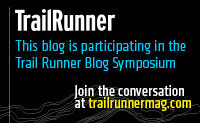(Το άρθρο δημοσιεύτηκε στην εφημερίδα «Ηπειρωτικός Αγώνας» στις 20/2/2014)
Στις 26 και 27 Ιουλίου θα γίνει φέτος ο τέταρτος ορεινός αγώνας δρόμου στο Ζαγόρι, το «The North Face Zagori Mountain Running 2014». Η διοργάνωση φιλοδοξεί να ξεπεράσει τα στενά όρια της Ελλάδας και να δελεάσει αθλητές και από άλλες χώρες, γειτονικές και μη.
Τέσσερις μεγάλοι αγώνες (80χλμ, 42χλμ, 22χλμ και 10χλμ) καθώς και πολλάhappenings για τα μικρά αλλά και τα μεγαλύτερα παιδιά, είναι σίγουρο πως θα κάνουν την περιοχή του Ζαγορίου να ζωντανέψει με τα χρώματα και τις φωνές των ανθρώπων που λατρεύουν την φύση και τον αθλητισμό. Ο Γιάννης Παπαστύλος γράφει για το ορεινό τρέξιμο και έχει όλες τις λεπτομέρειες για το άθλημα, την ιστορία του και τις απαιτήσεις του.Καλό είναι να μάθουμε όλοι μας τι ακριβώς είναι το ορεινό τρέξιμο. Εξάλλου, με τόσα βουνά που μας περιτριγυρίζουν, πρέπει να αισθανόμαστε τυχεροί που έχουμε τόσους πολλούς και καλούς «στίβους» κοντά μας να μας αναμένουν.
Το ορεινό τρέξιμο- mountain running ή trail running όπως είναι η διεθνής του ονομασία- δεν είναι κάτι το καινούργιο. Αγώνες ορεινού τρεξίματος αναφέρονται μέχρι και χίλια χρόνια πριν στη Σκωτία με σκοπό να βρεθεί ο γρηγορότερος ταχυδρόμος για να παραδίδει την αλληλογραφία του βασιλιά. Για να μην πούμε ότι στην ουσία ορεινός δρομέας ήταν και ο Φειδιππίδης που έτρεξε τη διαδρομή Αθήνα-Σπάρτη για να ζητήσει τη βοήθεια των Σπαρτιατών στη μάχη του Μαραθώνα.
Καταρχήν, να διευκρινίσουμε ότι δεν πρέπει να υπάρχει σύγχυση μεταξύ του ορεινού τρεξίματος και της ορειβασίας. Το ορεινό τρέξιμο είναι αυτό ακριβώς που λέει η λέξη. Τρέξιμο. Η IAAF κατατάσσει το ορεινό τρέξιμο στην κατηγορία των Athletics μαζί με τον στίβο, τους αγώνες δρόμου, το βάδην, και το cross country τρέξιμο. Η μεγάλη και πραγματική διαφορά με τα υπόλοιπα αγωνίσματα δρόμου είναι η αντικειμενική αδυναμία του να υπάρχει ρεκόρ απόστασης, μιας και ο κάθε αγώνας είναι τόσο διαφορετικός από τον άλλο έτσι ώστε η απόσταση να αποτελεί τις περισσότερες φορές τον ελάχιστο παράγοντα δυσκολίας. Για να γίνει πιο σαφές αυτό, σκεφτείτε την διαφορά μεταξύ 44 χιλιομέτρων ανάβασης και κατάβασης στον Όλυμπο και 44 χιλιομέτρων στους λόφους και τα μονοπάτια γύρω γύρω από τα Γιάννενα. Ο στίβος, τελικά, είναι αυτός που καθορίζει την δυσκολία του αγώνα. Ο στίβος και οι καιρικές συνθήκες. Η βροχή, η λάσπη, το χιόνι, οι πέτρες, ο ήλιος και η σκόνη καθώς και οι απότομες ανηφόρες και κατηφόρες δεν αποτελούν εμπόδια στο άθλημα αυτό, αλλά μέρος της απόλαυσης.
Πολλοί αθλητές και ιδίως οι αθλητές αντοχής προσθέτουν στο προπονητικό τους πρόγραμμα ασκήσεις στο βουνό ή γενικά σε υψόμετρο γιατί τους βοηθά στο να βελτιώσουν πολύ το καρδιοαναπνευστικό τους σύστημα και τα επίπεδα αντοχής τους.
Τι χρειάζεται κανείς για να ασχοληθεί με το ορεινό τρέξιμο; Στην ουσία, μόνο ένα ζευγάρι κατάλληλα αθλητικά παπούτσια. Από εκεί και πέρα, όπως λένε και οι Άγγλοι, ο ουρανός είναι το όριο. Οι αθλητικές εταιρείες έχουν καταλάβει προ πολλού την δυναμική του αθλήματος και παρουσιάζουν χρόνο με το χρόνο όλο και πιο λεπτομερείς συλλογές με ρούχα και αξεσουάρ που δεν θα αφήσουν κανένα ανικανοποίητο. Παπούτσια, κάλτσες, κολάν, τεχνικές μπλούζες, αδιάβροχα, αντιανεμικά, σκουφάκια, ρολόγια, καρδιοσυχνόμετρα και άλλα ων ουκ έστιν αριθμός, καθώς και παγούρια, ροφήματα και τροφές θα βοηθήσουν τον καθένα είτε να κάνει το χόμπι του είτε να προσπαθήσει να γίνει πρωταθλητής.
Εμείς εδώ στα Γιάννενα, θεωρούμαστε προνομιούχοι στις τάξεις των ορεινών δρομέων. Ο λόγος είναι προφανής. Η πόλη μας περιτριγυρίζεται από βουνά και λόφους και η πρόσβαση σε κάποιο μονοπάτι για προπόνηση είναι πάρα πολύ εύκολη. Το δασάκι στο Φρόντζο βρίσκεται στην κυριολεξία μέσα στην πόλη. Στην ευρύτερη περιοχή διοργανώνονται τα τελευταία χρόνια πολλοί αγώνες, όπως οι ορεινοί αγώνες Λύγγου στη Ζίτσα, ο Άθλος Τζουμέρκων, Ο Δρόμος της Αρκούδας στο Μέτσοβο με διοργανωτή τον τεράστιο αθλητή τον Νίκο Καλοφύρη και φυσικά το κορυφαίο The North Face ZagoriMountain Running με διοργανωτή τον γιαννιώτη Βασίλη Τζουμάκα, ιδιοκτήτη των καταστημάτων Fifth Element στα Γιάννενα, με εξειδίκευση στον ορεινό αθλητισμό (τρέξιμο, σκι, snowboard, ορειβασία κ.α.). Οι αγώνες αυτοί εκτός του αθλητικού ενδιαφέροντος, προσελκύουν πολύ κόσμο στους ορεινούς όγκους της περιοχής μας, προσφέροντας προστιθέμενη αξία στα χωριά που θα φιλοξενήσουν τους αθλητές και τους συνοδούς τους.
Αντί για επίλογο, αξίζει να αναφερθεί η παντελής έλλειψη κακώς εννοούμενου ανταγωνισμού. Βοηθά σε αυτό το γεγονός ότι τα έπαθλα των νικητών είναι ένα μετάλλιο και τα πολλά μπράβο των συναθλητών τους. Δεν είναι καθόλου σπάνια η εικόνα να τερματίζουν σε αγώνες, αθλητές ο ένας δίπλα στον άλλο, αγκαλιά, χωρίς να τους ενδιαφέρει αν είναι πρώτοι ή τελευταίοι. Ο αντίπαλος είναι το βουνό και ο συναθλητής σου πολλές φορές είναι αυτός που θα σε βγάλει από μια δύσκολη θέση. Η συχνότατη και καθολική παραδοχή του λόγου για τον οποίο ασχολούνται οι περισσότεροι με το ορεινό τρέξιμο μπορεί να συνοψιστεί στο: «Τρέχω για να κερδίσω τον εαυτό μου και κανέναν άλλο».
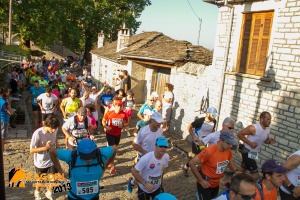
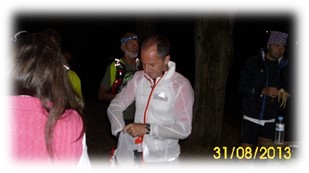 Seventy six ultra-runners stood ready and eager at the starting line and the spirits were high. I watched semi-jealously as these athletes got on their way, hitting the steep slope that awaited them just outside the picturesque village of Tsepelovo in the northern region of Ioannina prefecture. I started having wild thoughts about me being a contender the coming year, even though I knew that this was a ridiculous idea even for a dream.
Seventy six ultra-runners stood ready and eager at the starting line and the spirits were high. I watched semi-jealously as these athletes got on their way, hitting the steep slope that awaited them just outside the picturesque village of Tsepelovo in the northern region of Ioannina prefecture. I started having wild thoughts about me being a contender the coming year, even though I knew that this was a ridiculous idea even for a dream. them on a small van and proceeded to the central race station at the village of Papiggo. I arrived there, little after seven thirty and started, with the help of the local folks, to prepare and set up the station in order to be ready well before 10:30 am –the time that the first athlete was expected to arrive. Boiled potatoes, soup, pasta, watermelon, chocolate cakes, salt, isotonic drinks, Coke, and lots of fresh water were set on the two long tables under the shadow of the village church’s bell house.
them on a small van and proceeded to the central race station at the village of Papiggo. I arrived there, little after seven thirty and started, with the help of the local folks, to prepare and set up the station in order to be ready well before 10:30 am –the time that the first athlete was expected to arrive. Boiled potatoes, soup, pasta, watermelon, chocolate cakes, salt, isotonic drinks, Coke, and lots of fresh water were set on the two long tables under the shadow of the village church’s bell house. The drop bags were separated in tens and I asked a local teenager to help keep track of the arrival time of each participant, since our station was also a check point and had a time limit. The runners that would not be able to reach the central station under 10 hours (3.15pm) would be eliminated, and would not be allowed to go any further. I and Kostis (a runner-friend from Metsovo) were the ones to break the bad news to them.
The drop bags were separated in tens and I asked a local teenager to help keep track of the arrival time of each participant, since our station was also a check point and had a time limit. The runners that would not be able to reach the central station under 10 hours (3.15pm) would be eliminated, and would not be allowed to go any further. I and Kostis (a runner-friend from Metsovo) were the ones to break the bad news to them.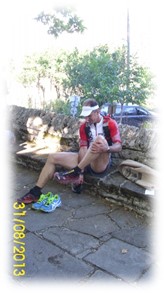 Monodentri and the next and last time limit of 16 hours from the beginning of the race.
Monodentri and the next and last time limit of 16 hours from the beginning of the race. and sent them on their way down the Vikos gorge. Time was flying by and without realizing it my clock notified me that there were only 15 minutes left to reach the time limit of 10 hours from the beginning of the race. I contacted the previous station and was informed that there were two last runners that passed their checkpoint and were heading our way. I knew that it would be a close call and I was hoping to skip the gruesome task of eliminating them from the rest of the race.
and sent them on their way down the Vikos gorge. Time was flying by and without realizing it my clock notified me that there were only 15 minutes left to reach the time limit of 10 hours from the beginning of the race. I contacted the previous station and was informed that there were two last runners that passed their checkpoint and were heading our way. I knew that it would be a close call and I was hoping to skip the gruesome task of eliminating them from the rest of the race.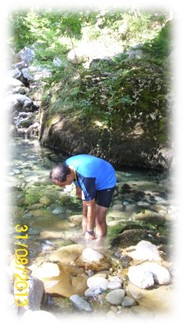 stopping now and then, for them to rest and catch their breath. That (I realized later) was a bad idea. Even though, one of them, being extremely tired from the race and the heat, came to terms with the idea that he would not go all the way, the other one exploded with curses and foul language for every and any one responsible for the race. I could certainly sympathize with him, but I could also put two and two together. The pace we were going would get him to the finish line next morning, jeopardizing his wellbeing. Anyway, to make a long story short, we were arguing, sometimes politely, sometimes angrily (from his part) all the way to Monodentri village. We missed the deadline by 50 minutes and the last safety party had left.
stopping now and then, for them to rest and catch their breath. That (I realized later) was a bad idea. Even though, one of them, being extremely tired from the race and the heat, came to terms with the idea that he would not go all the way, the other one exploded with curses and foul language for every and any one responsible for the race. I could certainly sympathize with him, but I could also put two and two together. The pace we were going would get him to the finish line next morning, jeopardizing his wellbeing. Anyway, to make a long story short, we were arguing, sometimes politely, sometimes angrily (from his part) all the way to Monodentri village. We missed the deadline by 50 minutes and the last safety party had left. I had my car brought to Monodentri by a friend so I took both those men and drove them back to Tsepelovo. On the way there I kept hearing the «angry» one telling me the same things I heard all through the gorge. Call it intuition, call it a desperate try to stop his nagging, I turned my head and told him that, even though, they did not finish the race, I would ask the race director to award those two with the medal reserved for the finishers, in order to reward them for their great effort. Magically, that was it. No more nagging, no more foul language, no more bitterness. We reached Tsepelovo at about 9:30pm, had a great dinner, celebrated with the others and watched the last of the participants cross the finishing line.
I had my car brought to Monodentri by a friend so I took both those men and drove them back to Tsepelovo. On the way there I kept hearing the «angry» one telling me the same things I heard all through the gorge. Call it intuition, call it a desperate try to stop his nagging, I turned my head and told him that, even though, they did not finish the race, I would ask the race director to award those two with the medal reserved for the finishers, in order to reward them for their great effort. Magically, that was it. No more nagging, no more foul language, no more bitterness. We reached Tsepelovo at about 9:30pm, had a great dinner, celebrated with the others and watched the last of the participants cross the finishing line.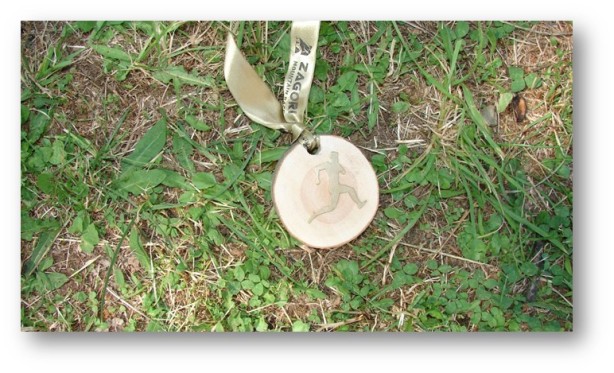 to stop, telling you that you are too tired, too thirsty, too hungry, too disoriented. That small piece of metal or wood is worth 100 times its weight in gold to our minds.
to stop, telling you that you are too tired, too thirsty, too hungry, too disoriented. That small piece of metal or wood is worth 100 times its weight in gold to our minds.